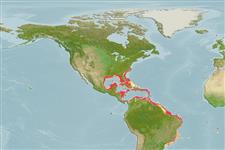>
Anguilliformes (Eels and morays) >
Muraenidae (Moray eels) > Muraeninae
Etymology: Gymnothorax: Greek, gymnos = naked + Greek, thorax, -akos = breast (Ref. 45335).
More on author: Cuvier.
Environment: milieu / climate zone / kisaran kedalaman / distribution range
Ekologi
laut berasosiasi dengan karang; kisaran kedalaman 0 - 200 m (Ref. 9710), usually 0 - 35 m (Ref. 40849). Subtropical; 37°N - 26°S, 98°W - 5°W
Western Atlantic: North Carolina, USA and Bermuda to Brazil, including the Gulf of Mexico, the Caribbean to southeastern Brazil. Eastern Atlantic: Ascension and St. Helena (Ref. 4450). Mid- and eastern Atlantic islands (Ref. 26938).
Size / Weight / umur
Kematangan: Lm ? range ? - ? cm
Max length : 200 cm TL jantan/; (Ref. 57911); common length : 60.0 cm TL jantan/; (Ref. 5217); Berat maksimum terpublikasi: 2.5 kg (Ref. 40637)
Moderate-size moray with a pattern of distinct small, round, overlapping dark brownish to purplish-black spots on white or pale yellow background (Ref. 26938).
Body shape (shape guide): eel-like.
A benthic and solitary species (Ref. 26340) abundant in shallow rocky and grassy areas and on coral reefs; less common in turbid bays or harbors. Its bite is very dangerous (Ref. 5217). Active during the day, sometimes together with other predators. Feeds on fish and crustaceans (Ref. 42064). Usually seen with its head protruding from a hole and the rest of its body concealed (Ref. 26938). Observed to be unusually aggressive towards man (Ref. 86997). It has been traded as aquarium fish at Ceará, Brazil (Ref. 49392). Marketed fresh and salted (Ref. 5217).
Life cycle and mating behavior
Kematangan | Reproduksi, perkembang biakan | Pemijahan | telur-telur | Fecundity | Larva
Spawning migrations, leptocephalus larvae.
Robins, C.R. and G.C. Ray, 1986. A field guide to Atlantic coast fishes of North America. Houghton Mifflin Company, Boston, U.S.A. 354 p. (Ref. 7251)
Status IUCN Red List (Ref. 130435: Version 2025-1)
ancaman kepada manusia
Traumatogenic (Ref. 5217)
penggunaan manusia
Perikanan: nilai komersial kecil; Akuarium: Komersial
Alat, peralatan
laporan khas
muat turun XML
Sumber internet
Estimates based on models
Preferred temperature (Acuan
123201): 23.3 - 28, mean 26.5 °C (based on 630 cells).
Phylogenetic diversity index (Acuan
82804): PD
50 = 0.5000 [Uniqueness, from 0.5 = low to 2.0 = high].
Bayesian length-weight: a=0.00056 (0.00037 - 0.00085), b=3.27 (3.15 - 3.39), in cm total length, based on LWR estimates for this species & Genus-body shape (Ref.
93245).
Trophic level (Acuan
69278): 4.5 ±0.8 se; based on diet studies.
Daya lenting (Acuan
120179): Rendah, Waktu penggandaan populasi minimum 4.5 - 14 tahun (Assuming tmax>10).
Fishing Vulnerability (Ref.
59153): Very high vulnerability (90 of 100).
🛈
Nutrients (Ref.
124155): Calcium = 10.1 [4.9, 20.1] mg/100g; Iron = 0.399 [0.211, 0.819] mg/100g; Protein = 19.5 [17.2, 22.0] %; Omega3 = 0.161 [0.064, 0.501] g/100g; Selenium = 32.8 [15.0, 68.8] μg/100g; VitaminA = 41.4 [10.9, 160.5] μg/100g; Zinc = 0.431 [0.281, 0.657] mg/100g (wet weight);
